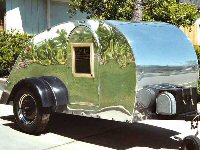I found two documents. One is on an Internet site and you can look at it here:
http://www.mastercomposter.com/worm/wormcomp.htmlAlso, there was a lady, a dear friend who passed this winter, who used to give talks on worm composting. She used to do worm composting under her kitchen sink. The following is from her hand-out plus the notes I took from one of her talks:
Type of Worms to Use:Use “Red worms” for vermicomposting because they will reproduce more worms quickly in a confined container. These worms are also known by the names, “Red Worms”, or “Red Wiggler”. The scientific name is “Eisenia foetida”, pronounced:
I SEE NEE A, FET ID A. You can usually find these at a worm farm or bait shop.
Providing a Worm Home:You can build a wooden box or simply use a convenient sized plastic container which has a lid.
Worms need a nice damp bed of paper under them. Use strips of newspaper. Newspaper breaks down easier and the ink is made from vegetable dye, which is safer. Make that bed 2” thick. Put a rack in the bottom of your box so the excess liquid can drain off so the worms won’t drown. Drain the excess water out occasionally. Worms also need a blanket of damp shredded newspaper bedding or shredded lettuce over top. Fluff up their shredded newspaper bed occasionally to insure air can circulate.
You will need to drill holes in the container lid to provide air. Be certain that the holes are not so big that the worms can escape and wander away. It’s a good idea to use a screen under the lid because the worms do like to browse around at night. (My friend began adding a screen after she accidentally left the lid ajar. The next morning, the worms were all over her kitchen floor!)
What to Feed Your Worms:DO NOT FEED YOUR WORMS MEAT OR DAIRY PRODUCTS. NO MILK, CHEESE, YOGURT, ETC. Rotted meat and spoiled dairy products will produce a bad or unpleasant odor. Your worm bin should never have a bad odor. If it does, you are doing something wrong. You may be feeding more than the worms can eat; or, you may have added food that should not be there.
< As an aside, I don't know about feeding worms the material from a toilet. It may make them sick or they may not eat it or it may simply make the mixture too "hot". It may give your bin a foul odor, also. I've never heard of anyone feeding manure to worms. We were told not to add in animal feces or anything like that to a regular compost pile because it takes too long to break down. It's my understanding that manure may elevate the temperature too high, also. With cow and horse manure, it must sit and compost by itself for about a year before it can be used on a garden or it will kill/burn the vegetables that you are trying to grow. You may be better off composting it separately or simply burying such material. Please keep in mind that the worm soil should have a ph range of between 4.2 (low) to 8.0 (high). Feces and urine can be highly acidic. >Worms like nice soft foods, bananas, peels, and such are favorites. Apples, lettuce, coffee grounds, tea bags or any soft food will do nicely. They will eat newspaper, too.
If you want to give them food which may be too hard, such as broccoli or cauliflower stems, you can cut them into small cubes and sprinkle with a little water and cook the cut pieces in the microwave for 4 or 5 minutes. The secret to food preparation for worms is to cut the food in small pieces and serve it as soft as possible.
- A pound of worms (about 1000 worms), can eat a pound of food a day.
Helping Your Worms’ digestion: Worms need a little help with their digestive process. Every month or so, sprinkle a bit of fine sand, soil, or very finely crushed egg shells (put in blender to crush) over their food to improve their digestion. This coarse addition will be used in the worms’ gizzard to grind their food and move it along to becoming a wonderful plant supplement. You can use ½ cup builders’ sand to start. Sprinkle it in lines so the worms can get at it but it won’t heat up the whole compost pile.
When/How to Harvest the Fertilizer:When you observe that your worm bin is getting too full, it may be time to begin harvesting the castings.
Three or four weeks before you might want to harvest, begin feeding on one side of your worm bin only. This is so that the worms will move over to where the food is being provided.
When you feel the worms have moved over, put on some plastic gloves and reach in and take out the castings on the side where you are not feeding. You may still have a few worms left on the side where you are harvesting; but, you may either manually take them out or leave them in. They can go right into your garden and become part of the outdoor eco-system.


 Danny
Danny Danny
Danny

 Danny
Danny
 ..I'm not going to drink it ....Eww
..I'm not going to drink it ....Eww ...My idea is to use 5 gallon buckets and to have about ten of them so they can be switched out weekly but still be given a chance to dry out and do their own breaking down of the matter ..as to cool down the hot mix there are some additives that can be added in order to make the compost more viable for use on edible plants..as I'd like to be able to go full circle with the waste material and have it turn into something usable I might not be using it but if the final product can just be dumped safely in the woods that would be my goal..just anther way to help reduce my carbon foot print and all that jazz...thank you to all for your input I'm always looking for more so if you know more or just have questions I'd like to hear them
...My idea is to use 5 gallon buckets and to have about ten of them so they can be switched out weekly but still be given a chance to dry out and do their own breaking down of the matter ..as to cool down the hot mix there are some additives that can be added in order to make the compost more viable for use on edible plants..as I'd like to be able to go full circle with the waste material and have it turn into something usable I might not be using it but if the final product can just be dumped safely in the woods that would be my goal..just anther way to help reduce my carbon foot print and all that jazz...thank you to all for your input I'm always looking for more so if you know more or just have questions I'd like to hear them Danny
Danny
 I think that's probably why people for decades plus used outhouses to bury feces deep, where it would have time to work at decomposing and becoming part of the soil. I don't know what the laws are everywhere in the US or in Canada; but, I believe that most places have a rule that outhouses or septic drain fields must be at least 200 feet from any stream, creek, river, lake, water well, etc. I would think that a similar rule would apply to dumping in the woods, if it was even allowed. This is because of possible contamination. It would be best to check ones local laws before embarking on a dung decomposition program.
I think that's probably why people for decades plus used outhouses to bury feces deep, where it would have time to work at decomposing and becoming part of the soil. I don't know what the laws are everywhere in the US or in Canada; but, I believe that most places have a rule that outhouses or septic drain fields must be at least 200 feet from any stream, creek, river, lake, water well, etc. I would think that a similar rule would apply to dumping in the woods, if it was even allowed. This is because of possible contamination. It would be best to check ones local laws before embarking on a dung decomposition program.